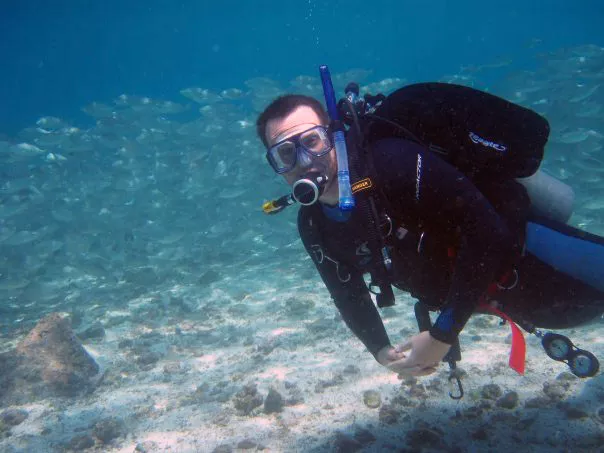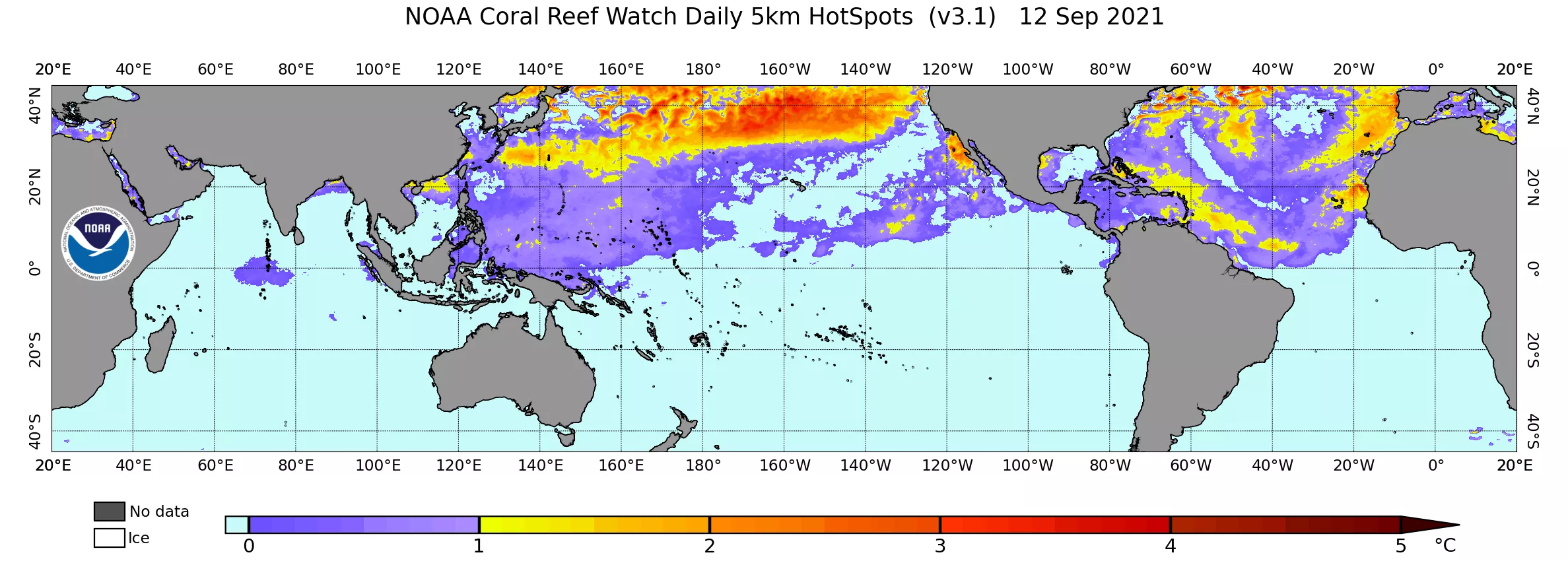
Earlier this year, Derek Manzello, Ph.D., an award-winning coral reef ecologist, became the new head of NOAA’s Coral Reef Watch (CRW), which monitors the world’s coral reef ecosystems through satellite and natural observations. During his career, Manzello has made more than 1,000 scientific dives, while researching coral reefs in all U.S. jurisdictions, and international locations in the Pacific (Galapagos, Panama, French Polynesia, Fiji, Palau, Papua New Guinea) and Indian oceans (Chagos Archipelago).
He recently discussed the impact of the changing climate on coral reefs and CRW’s role as the source of the only global early-warning system for threats to the coral reef ecosystem.
Question: You're several months into your new role as federal coordinator at NOAA's Coral Reef Watch (CRW). What’s your take, so far, on the current state of the world's coral reefs, and what have you learned since being in this position?
Answer: Coral reefs are globally in decline. Every reef region on the planet has been negatively impacted by human activities. To put it bluntly, the current state of the world’s coral reefs is alarming because ocean warming is accelerating and this poses the biggest threat to the continued existence of coral reef ecosystems as we know them. Most climate projections predict that severe coral bleaching events will occur every year for nearly every coral reef on the planet by 2050. Based on what we know about the response of corals and coral reef ecosystems to heat stress, the prognosis for reefs once yearly severe bleaching begins is dire. Under an annual severe bleaching scenario, the corals will never be able to recover, but will be in a state of chronic bleaching until there is attrition of most corals.
Recent research has shown that some coral species do possess some capacity to acclimatize or adapt to heat stress, and as such, scientists and managers are urgently engaged in coral reef restoration using cutting-edge assisted evolution activities to try and restore degraded coral reefs with heat tolerant corals. It truly is a race against time for scientists and resource managers, and the clock is ticking.
Question: NOAA experts recently announced July 2021 was Earth’s hottest month on record. How are changes in the climate—from intense heat waves to persistent and prolonged warming ocean temperatures—impacting the health and function of the world's corals and reefs?
Answer: Marine heatwaves are increasing in magnitude, duration, and spatial extent as a result of climate change. This is an existential threat to coral reefs because reef-building corals live very near their upper thermal limits. If ocean temperatures are higher than average by as little as 1-2 degree Celsius (2-3 degrees Fahrenheit) during the warmest part of the year for a month or more, corals will experience bleaching. Coral bleaching is the breakdown in the symbiotic relationship between the coral animal host and its algal symbionts—its main source of nutrition. The algal symbionts provide up to 95% of the corals’ food, but this symbiotic relationship is highly sensitive to heat stress. During marine heatwaves, the algal symbionts are expelled by the coral animal because high temperatures coupled with high solar radiation cause the algae to become toxic and produce free oxygen radicals that damage tissues. When a coral loses its algal symbionts, it’s essentially starving to death and turns white (or ‘bleached’) because the symbionts provide much of the corals’ color.
The damage that corals experience from marine heatwaves is a function of the duration, or how long the heat stress occurs, plus the magnitude of the heat stress anomaly. Corals can recover from bleaching if the heat stress subsides, but they will have impaired growth, reproduction, and be susceptible to disease for 2-3 years after recovery. Corals that are also impacted by land-based sources of pollution can take upwards of 8 years to recover the growth rates they had prior to bleaching. If the heat stress does not subside, the coral will die. Mortality becomes likely if the corals experience sea temperatures 1°C greater than average for 2 months, or 2°C greater than average for 1 month. Also, if there is a large thermal anomaly, say 3°C, then the corals would be expected to start experiencing mortality in less than three weeks. It is a time and dose response.
Question: CRW provides intelligence for early detection, on-the-ground response, communication about mass coral bleaching, and future resilience planning. How can CRW, especially working with its partners, better support researchers and the decision makers, who protect coral ecosystems?
Answer: CRW was the first and is still the only global coral bleaching monitoring network. The importance and success of CRW can be seen by the caliber of some of its most dedicated international users and partners, such as the University of Queensland and Australian Institute of Marine Science. CRW communicates with its users about the existence of environmental conditions that can lead to coral bleaching. This is done in near-real-time, but we also provide bleaching outlook forecasts of the anticipated sea surface temperatures for the next four months.
Thus, on-the-ground resource managers have an understanding of the amount of heat stress their reefs are experiencing, and can plan in advance for any intervention activities. For example, local dive shop operators in Thailand stopped SCUBA diving on certain reefs that were experiencing intense heat stress so as to limit the added stressor of humans interacting with the bleaching reefs. Efforts like this are vital because managers cannot stop bleaching from happening and must focus their efforts on reducing concomitant stressors that may exacerbate bleaching impacts. Moving forward, CRW products are going to be key for coral restoration activities, as managers will need to incorporate information of bleaching frequency and severity in their plans to shepherd coral reef ecosystems through this century.

Question: How might CRW use information from the Bulletin of the AMS State of the Climate for 2020 and the Intergovernmental Panel on Climate Change in its efforts?
Answer: CRW scientists and products have contributed to past IPCC efforts. The information in these types of reports is important for CRW to understand other factors in the climate system and how those interact and drive the sea surface temperature patterns we observe in our monitoring.

Question: Where would you like to see CRW within the next three-to-five years? In particular, what new products would you like to see CRW develop and release to its global user community?
Answer: On a global scale, CRW is developing new products to estimate the risk for coral disease outbreaks in a partnership with NASA, as well as an exciting new product that will predict coastal flooding of coral reef-lined coasts throughout the entire world. Locally on US coral reefs, CRW will be engaging with managers of the Mission: Iconic Reefs project that aims to restore seven iconic reefs in the Florida Keys. CRW will work to provide site-specific, high-resolution temperature data to help guide restoration and outplanting activities to help ensure the greatest chances of success for restoration activities.
For more information about NOAA's Coral Reef Watch visit coralreefwatch.noaa.gov.
